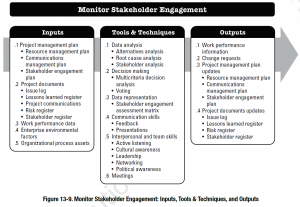
Monitor Stakeholder Engagement is the 4th out of four processes within the Project Stakeholder Management knowledge area within the Project Management Body of Knowledge (PMBOK).
It occurs within the Monitoring & Controlling process group.
The inputs, tools & techniques, and outputs are as follows:
Inputs
- Project Management Plan
- Resource management plan
- Communications management plan
- Stakeholder engagement plan
- Project documents
- Issue log
- Lessons learned register
- Project communications
- Risk register
- Stakeholder register
- Work performance data
- Enterprise environmental factors
- Organizational process assets
Tools and Techniques
- Data analysis
- Alternatives analysis
- Root cause analysis
- Stakeholder analysis
- Decision making
- Multicriteria decision analysis
- Voting
- Data representation
- Stakeholder engagement assessment matrix
- Communication skills
- Feedback
- Presentations
- Impersonal and team skills
- Active listening
- Cultural awareness
- Leadership
- Networking
- Political awareness
- Meetings
Outputs
- Work performance information
- Change requests
- Project management plan updates
- Resource management plan
- Communications management plan
- Stakeholder engagement plan
- Project documents updates
- Issue log
- Lessons learned register
- Risk register
- Stakeholder register
Monitor Stakeholder Engagement
It might be intuitive that since the first two processes in the knowledge area, Identify Stakeholders and Plan Stakeholder Management, are within the planning group and the third, Manage Stakeholder Engagement, is within the Execution group, that the first two produce a component of the project management plan (the stakeholder register and stakeholder engagement plan, respectively) and the third involves the carrying out of the plan.
But what does project control mean in relation to stakeholders?
The answer is that stakeholder’s needs change, resulting in a need to update those documents. It is a common occurrence, actually, that the project activities result in dissatisfaction in a different area, or the level of dissatisfaction on an existing area goes up or down. In either case, the underlying factors driving a stakeholder require another analysis. The stakeholder register produced in the first process needs to be revisited if the stakeholder needs to be struck off, and the stakeholder engagement plan produced in the second process needs to be revisited if any part of the stakeholder analysis has changed.
Hence, at the designated project control points, when earned value calculations take place and progress reporting occurs, stakeholder control involves the following things:
- Ensuring the stakeholder engagement plan has been executed as planned.
- Updating the stakeholder engagement assessment matrix for any stakeholders that have achieved project buy-in (or moved from any category) during the period.
- Updating the stakeholder engagement plan. Stakeholder responses during the period are inspected and if their stakeholder analysis has changed, the engagement plan is updated accordingly.







